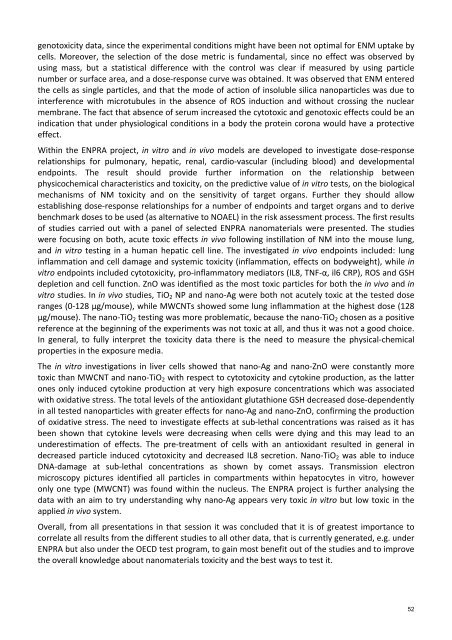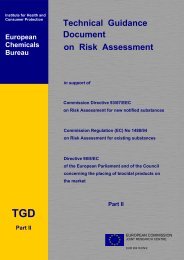Challenges of Regulation and Risk Assessment of Nanomaterials
Challenges of Regulation and Risk Assessment of Nanomaterials
Challenges of Regulation and Risk Assessment of Nanomaterials
You also want an ePaper? Increase the reach of your titles
YUMPU automatically turns print PDFs into web optimized ePapers that Google loves.
genotoxicity data, since the experimental conditions might have been not optimal for ENM uptake by<br />
cells. Moreover, the selection <strong>of</strong> the dose metric is fundamental, since no effect was observed by<br />
using mass, but a statistical difference with the control was clear if measured by using particle<br />
number or surface area, <strong>and</strong> a dose-response curve was obtained. It was observed that ENM entered<br />
the cells as single particles, <strong>and</strong> that the mode <strong>of</strong> action <strong>of</strong> insoluble silica nanoparticles was due to<br />
interference with microtubules in the absence <strong>of</strong> ROS induction <strong>and</strong> without crossing the nuclear<br />
membrane. The fact that absence <strong>of</strong> serum increased the cytotoxic <strong>and</strong> genotoxic effects could be an<br />
indication that under physiological conditions in a body the protein corona would have a protective<br />
effect.<br />
Within the ENPRA project, in vitro <strong>and</strong> in vivo models are developed to investigate dose-response<br />
relationships for pulmonary, hepatic, renal, cardio-vascular (including blood) <strong>and</strong> developmental<br />
endpoints. The result should provide further information on the relationship between<br />
physicochemical characteristics <strong>and</strong> toxicity, on the predictive value <strong>of</strong> in vitro tests, on the biological<br />
mechanisms <strong>of</strong> NM toxicity <strong>and</strong> on the sensitivity <strong>of</strong> target organs. Further they should allow<br />
establishing dose-response relationships for a number <strong>of</strong> endpoints <strong>and</strong> target organs <strong>and</strong> to derive<br />
benchmark doses to be used (as alternative to NOAEL) in the risk assessment process. The first results<br />
<strong>of</strong> studies carried out with a panel <strong>of</strong> selected ENPRA nanomaterials were presented. The studies<br />
were focusing on both, acute toxic effects in vivo following instillation <strong>of</strong> NM into the mouse lung,<br />
<strong>and</strong> in vitro testing in a human hepatic cell line. The investigated in vivo endpoints included: lung<br />
inflammation <strong>and</strong> cell damage <strong>and</strong> systemic toxicity (inflammation, effects on bodyweight), while in<br />
vitro endpoints included cytotoxicity, pro-inflammatory mediators (IL8, TNF-α, il6 CRP), ROS <strong>and</strong> GSH<br />
depletion <strong>and</strong> cell function. ZnO was identified as the most toxic particles for both the in vivo <strong>and</strong> in<br />
vitro studies. In in vivo studies, TiO2 NP <strong>and</strong> nano-Ag were both not acutely toxic at the tested dose<br />
ranges (0-128 μg/mouse), while MWCNTs showed some lung inflammation at the highest dose (128<br />
μg/mouse). The nano-TiO2 testing was more problematic, because the nano-TiO2 chosen as a positive<br />
reference at the beginning <strong>of</strong> the experiments was not toxic at all, <strong>and</strong> thus it was not a good choice.<br />
In general, to fully interpret the toxicity data there is the need to measure the physical-chemical<br />
properties in the exposure media.<br />
The in vitro investigations in liver cells showed that nano-Ag <strong>and</strong> nano-ZnO were constantly more<br />
toxic than MWCNT <strong>and</strong> nano-TiO2 with respect to cytotoxicity <strong>and</strong> cytokine production, as the latter<br />
ones only induced cytokine production at very high exposure concentrations which was associated<br />
with oxidative stress. The total levels <strong>of</strong> the antioxidant glutathione GSH decreased dose-dependently<br />
in all tested nanoparticles with greater effects for nano-Ag <strong>and</strong> nano-ZnO, confirming the production<br />
<strong>of</strong> oxidative stress. The need to investigate effects at sub-lethal concentrations was raised as it has<br />
been shown that cytokine levels were decreasing when cells were dying <strong>and</strong> this may lead to an<br />
underestimation <strong>of</strong> effects. The pre-treatment <strong>of</strong> cells with an antioxidant resulted in general in<br />
decreased particle induced cytotoxicity <strong>and</strong> decreased IL8 secretion. Nano-TiO2 was able to induce<br />
DNA-damage at sub-lethal concentrations as shown by comet assays. Transmission electron<br />
microscopy pictures identified all particles in compartments within hepatocytes in vitro, however<br />
only one type (MWCNT) was found within the nucleus. The ENPRA project is further analysing the<br />
data with an aim to try underst<strong>and</strong>ing why nano-Ag appears very toxic in vitro but low toxic in the<br />
applied in vivo system.<br />
Overall, from all presentations in that session it was concluded that it is <strong>of</strong> greatest importance to<br />
correlate all results from the different studies to all other data, that is currently generated, e.g. under<br />
ENPRA but also under the OECD test program, to gain most benefit out <strong>of</strong> the studies <strong>and</strong> to improve<br />
the overall knowledge about nanomaterials toxicity <strong>and</strong> the best ways to test it.<br />
52








